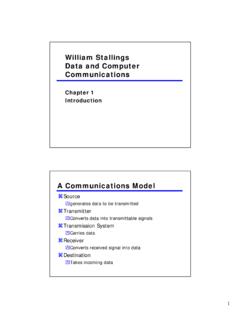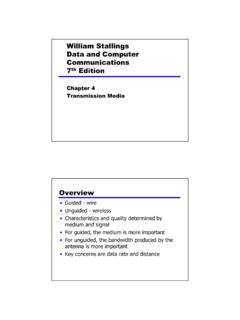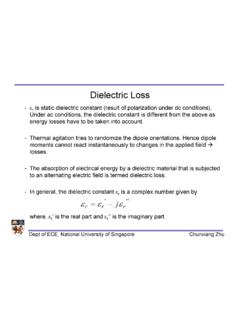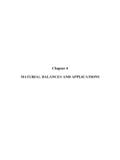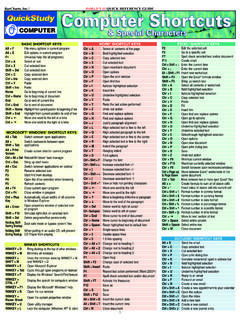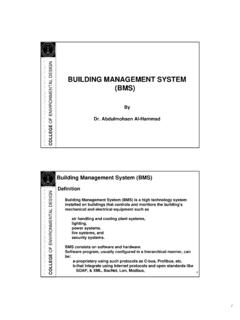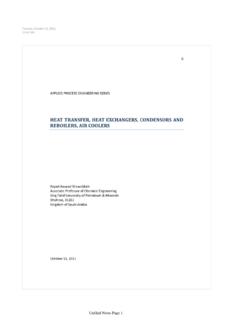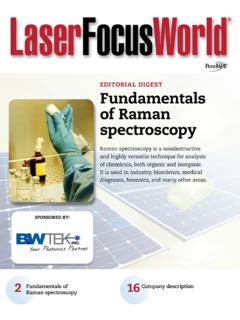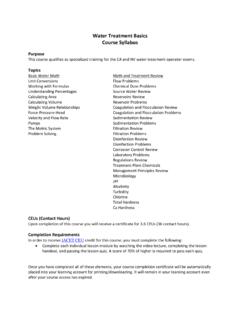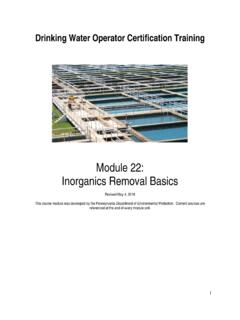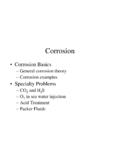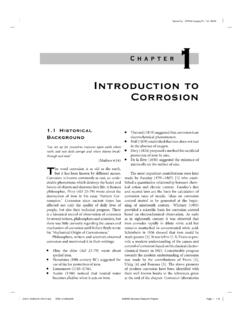Transcription of Protective Coatings - KFUPM
1 Protective CoatingsDr. Zuhair M. Gasem ME Dept, KFUPMD hahran, Saudi and corrosion protection handbook by A. Prevention by Protective Coatings by Munger(NACE) control by BradfordKFUPM-ME 472 (062)2 Coatings and Lining The most widely used method for corrosion control Billion dollar in 1997 for corrosion protection by Coatings A coat is a thin Protective layer, typically 50-100 m. A lining is thick, typically mm in thickness. Linings are usually applied in the interiors of tanks, pipes, vessels, where immersion is continuous and corrosion is severe. Coatings are usually applied on surfaces where immersion is not continuous such as the external surfaces of tanks and pipes. KFUPM -ME 472 (062)3 Coatings and Lining corrosion protection by Coatings can be achieved by one of the following mechanisms: barrier coating that prevents the corrosive environment from reaching the base metal (thick lining).
2 Sacrificial metal coating that corrodes while giving cathodic protection to the base metal (galvanizing). noble metal coating that ensures that the base metal is in thepassive state. inhibitor coating that slows electrode electrically resistive coating that slows down electrochemical corrosion reactions (organic coating ). Base metalCoating or liningKFUPM-ME 472 (062)4 coating Materials Coatings Materials Organic(Paints)MetallicInorganic ThermoplasticsElastomers (Rubber)ThermosettingsHow is it applied?Hot DippingZn (galvanizing)Al, and PbElectroplating(Ni, Cr, Zn, Sn, Cd)Thermally Sprayed(any metal inpowder form) CladdingStainless steel Conversion coatingsPorcelain enamels ChromatePhosphateAnodizingCement Linings Zn-rich coatingsWeld OverlayingPortland CementPotassium SilicateModified PotassiumSilicateCalcium AluminatesInorganic Zinc/SilicatesKFUPM-ME 472 (062)5 Organic Paints An organic paint consists of a liquid part known as a vehicle and a solid part.
3 The vehicle part consists of: A binder or a resin (non-volatiles, it does not evaporate after drying) A Solvent (volatiles) Liquid additives The solid part consists of Powdery particles or pigments Solid additives KFUPM -ME 472 (062)6 Binders A binder is an organic liquid (oil or resins) that forms a denseand tight Protective skin or film in different ways: Oxygen reactive binders: resins forming solid film by reacting with O2. Thermosetting resins such epoxy-esters, urethane-alkyds. Evaporation of the solvent which leaves behind a film of the polymer that was dissolved or suspended in water or oil based solvents. Thermoplastic resins such as PVC and acrylics Polymerization reaction Mixing a resin and a hardener (thermosets) The binder provides the basic coating properties in terms of chemical resistance, permeability, abrasion resistance, and hardness.
4 KFUPM -ME 472 (062)7 Binders: thermoplastics Thermoplastic binders: The solid film consists of entangled linear chains as shown in the figure. The most common thermoplastic binders are: Vinyls (polyvinyl chloride and polyvinyl acetate copolymer) high impermeability widely used for steel immersed in water highly resistant to oil and grease applied by spraying Acrylics (dissolved in water or solvents) Highly resistant to UV High stability of color Excellent for protection against atmospheric exposure Used in cars external bodyPoly-vinyl-chlorideacrylicKFUPM-ME 472 (062)8 Binders: Thermosets Thermosetting binders: The solid film consists of rigid 3-dimensional network of molecules. The most common thermoplastic binders are: Epoxy excellent resistance to acid and alkaline environments Excellent adhesion and used as primers Phenolic Poly-urethanes UV resistant Excellent abrasion resistant Used in aircraft, cars, Polyester Thick films (1 mm) Excellent abrasion resistantepoxyUrethanes phenolicsKFUPM-ME 472 (062)9 Binders: Thermosets An example showing polymerization of a thermosetting Polymer (phenolic)hardenerResin KFUPM -ME 472 (062)10 Binders: organic oils Organic oil binders: The solid film form after drying vegetable oils by oxidation to form 3-dimensional network of the oil molecules.
5 Takes long time to dry up (few days). The most common oil based binders are: Alkyd (Good resistant to atmospheric condition) linseed oil + ALCOHOL+ ORGANIC ACID KFUPM -ME 472 (062)11 Binders Zinc rich organic binders: combination of fine powder of zinc and an organic binder where Zn corrodes and provides galvanic protection to steel The binder can be any thermoplastic or thermosetting resins such as vinyls, acrylics, or epoxies. Commonly used as primersKFUPM-ME 472 (062)12 Binders The binder provides the following functions: Binding the pigments together Adherence to substrate (metal surface) Cohesion (strength of the coat) Flexibility to the coating film Abrasion resistance Anti-corrosive properties Chemical resistanceKFUPM-ME 472 (062)13 Solvents Solvents are added to keep the binder in solution during storage and to provide fluidity during application.
6 Examples: aromatic hydrocarbons (toluene, xylene) , alcohol, ethers, esters, water in latex paints. Solvents determine: Application properties Evaporation rate or drying time Flash point KFUPM -ME 472 (062)14 Pigments Pigments are solid particles in powder form that are added to the coat to: Produce desired color Determine opacity Protect the binder from UV radiation Inhibit corrosion Increase abrasion resistance Increase strength and toughness Improve coating adhesion Examples:(Na2 CrO4 , ZnPO3 , phosphates) KFUPM -ME 472 (062)15 Additives Additives are small amounts of solids or liquids that control a number of important features such as: speed of drying and curing Wetting agents Anti-skinning Settling and sagging agents Storage agents KFUPM -ME 472 (062)16 Definitions A coat: a liquid applied as a thin layer which is converted to a solid- Protective adherent film after DRYING.
7 Enamel: a coat that can form very smooth film. Varnish: a liquid that converts to a transparent solid film after application as a thin layer. Lacquer: a coating composition based on thermoplastic binders dissolved in organic solvent that dries by solvent evaporation. KFUPM -ME 472 (062)17 Requirements for Good Coats Chemical resistance Low moisture permeability Good adhesion Flexibility (expand and contract with the metal substrate) Good impact and abrasion resistance Ease of applications Durability Low cost Hence, no single coat can provide all needed properties For example: Coats for underground structures: resistance to abrasion Coats for atmospheric corrosion : resistance to UV Coats for marine environments: resistance to high humidity and Cl- Coats to industrial environments: resistance to high temp, high acidity We must use multiple coats to satisfy these requirements.
8 KFUPM -ME 472 (062)18 coating SystemTop Coat Resistant to Ion penetration Alkali Resistant Insulator pPrimer Adheres to substrate Resists corrosionMetal SurfaceIntermediateCoatLow moisture and vapor transfer rate50 m100 m20-50 mA coating system consists of multiple layers 472 (062)19 coating System Primer Coat: the coat next to the substrate. Strong adhesion to substrate Good adhesion to intermediate coat Resist chemical attack Resist water permeability Carries corrosion inhibitorKFUPM-ME 472 (062)20 coating System Intermediate Coat: the main function is to increase the thickness of the coat. To reduce rate of moisture permeability To increase chemical resistance To Increase resistance to electricity and impact, and abrasion Top Coat: in contact with the electrolyte. To provide durability To provide color, gloss, and texture Usually more dense but less thick than the intermediate.
9 KFUPM -ME 472 (062)21 coating Procedure of a coat Inspection and Testing maintenance Failure KFUPM -ME 472 (062)221. Surface PreparationGood surface preparation is essential for good coating performance. Objectives: To remove any foreign substance from the surface such as such asdirt, dust, oils, chemicals, and corrosion products by one of the following methods: solvent or chemical washing steam cleaning hand tool cleaning To create a profile to provide anchor to the binder for good mechanical adhesion. The surface roughness can be increased by: High pressure water-blasting Wet abrasive-blasting Air abrasive-blasting At least 25-50 m (1-2 mils) anchor pattern must be made to provide adhesion to the primer. Anchor patternKFUPM-ME 472 (062)231. Surface Preparation SP1 (solvent cleaning) using solvents to remove grease and oil SP2 (hand tool cleaning) using hand scrapers to remove dirt, dust, coat SP3 (power tool cleaning) using power wire brushes, grinders, sanders to remove llosecorrosion products SP4 (Flame cleaning) removing contaminants by a flame or high velocity oxyfuelburner KFUPM -ME 472 (062)241.
10 Surface Preparation SP5 (white metal blast) using abrasive blasting to remove oil, mill scale and paint. Uses high pressure air (690 kPa) with abrasives (Al2O3) Abrasive blasting can provide 50-115 m anchor pattern. KFUPM -ME 472 (062)25 KFUPM -ME 472 (062)262. Selection of a Coat System Factors considered in coating selection: Service environment Operating condition ( , a coat selected for acid environment should be resistant to acids) Temperature, humidity, contaminants (the coat selected should withstand the range of operating conditions) Ultra violet (UV) exposure Metal to be protected (the substrate) Chemical compatibility Thermal compatibility AdhesionKFUPM-ME 472 (062)272. Selection of a Coat system Factors considered in coating selection (cont.) Environmental regulations Standards Appearance and Color Cost Temperature and humidity at time of application Application during shutdowns or during operation ?
